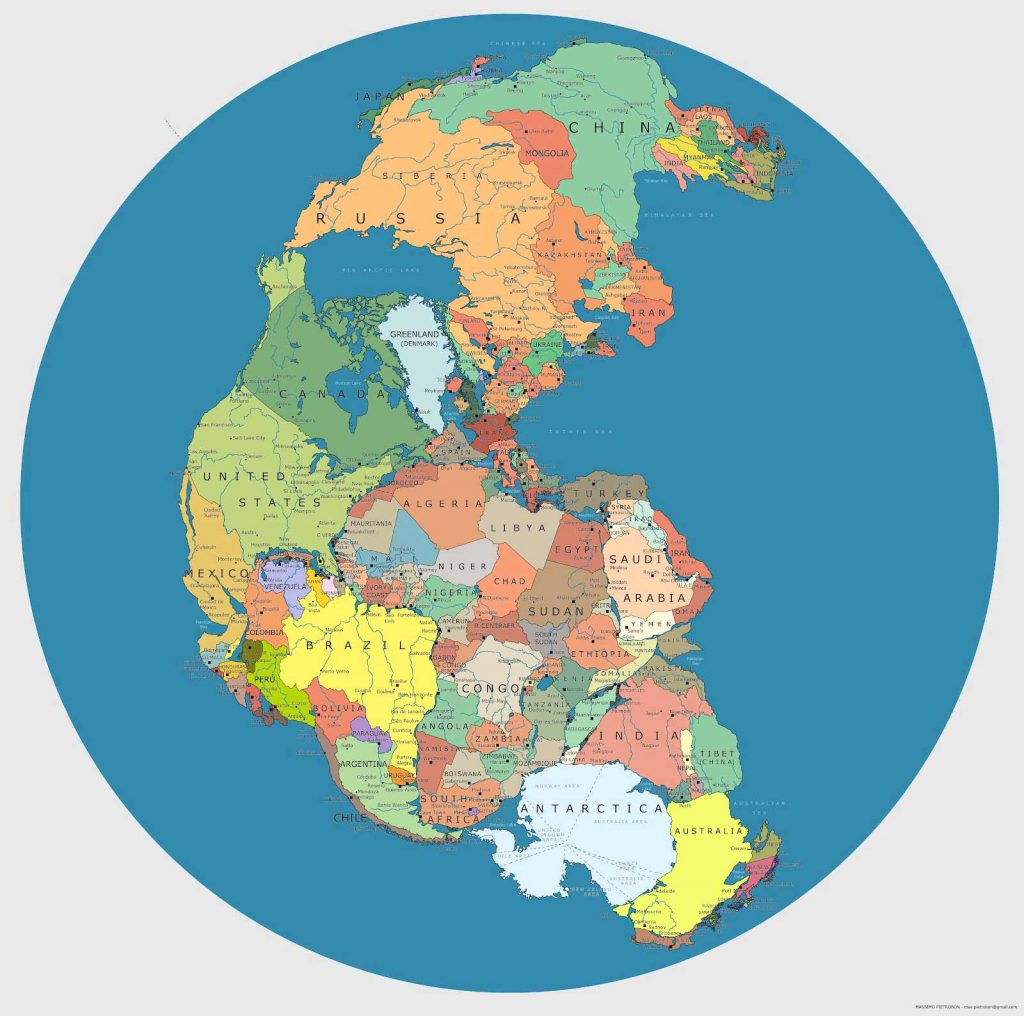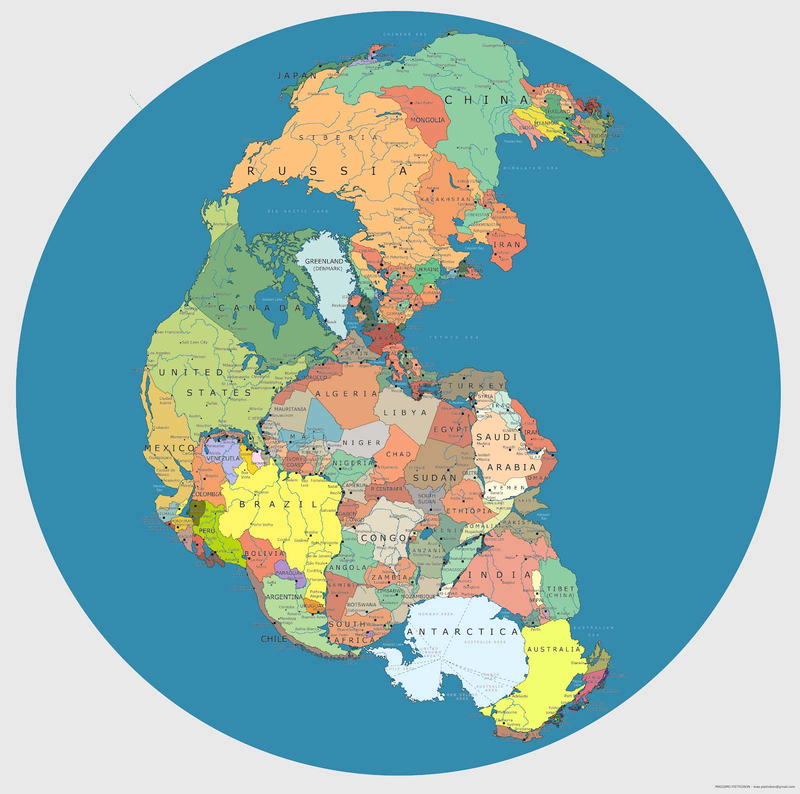About 300 million years ago, there was a supercontinent called Pangaea, whose name comes from Greek and means “the whole earth”. At that time, all of Earth’s emerged lands were in a single landmass, surrounded by the Panthalassa Ocean.

The Pangaea theory was proposed by Alfred Wegener, a German meteorologist and geophysicist, in 1912. According to his theory, the Earth’s continents had coalesced into a single supercontinent that then broke apart and shifted to its present position. Although the theory was widely criticized at the time, it was finally accepted by the scientific community in the 1960s, when geological evidence was found to support the idea of continental drift.
The theory of continental drift was not widely accepted by the scientific community for many years, but over time more evidence and proof accumulated, and eventually led to the development of the theory of plate tectonics, which explains how the Earth’s tectonic plates move and cause changes in the Earth’s surface.
Table of contents
How long did Pangaea exist?
Pangaea existed from about 299 million years ago (at the beginning of the Permian Period of geologic time) to about 180 million years ago (during the Jurassic Period).
For about 100 million years it remained complete and then began to break apart.
What is a supercontinent?
A supercontinent refers to a large land mass that may include a significant portion or all of the Earth’s continents and that has formed through geological processes, such as plate tectonics.
It is important to keep in mind that the definition of a supercontinent is subjective and may vary according to the criteria used. Some scientists argue that a landmass must include all major continents to be considered a supercontinent, while others may include only most of the continents.
The most recent supercontinent was Pangea, which included all of today’s continents and was located in the Earth’s southern hemisphere.
The process of formation and separation of supercontinents is known as the Wilson cycle and occurs through plate tectonics. As tectonic plates move and collide with each other, they may merge to form a supercontinent or separate to form separate continents.
Scientists have predicted that the next supercontinent will form in about 250 million years, when the current continents merge. Although it is not yet clear how this formation will occur, there are several theories. Some suggest that the resulting landmass will be called Amasia, while others suggest that it will be called Novopangea.
How did the supercontinent Pangaea form?
Pangea, the most recent supercontinent, was formed through the process of continents merging. Before Pangaea, the continents were scattered in small landmasses across the planet. During the Paleozoic era, there was a movement of tectonic plates that led to the gradual merging of the continents into a single landmass.
The process began with the formation of a large supercontinent called Gondwana, which included most of what is now South America, Africa, Antarctica, Australia, India and the Arabian Peninsula. At the same time, another supercontinent called Laurasia was forming from North America , Europe and Asia.

These two supercontinents eventually merged to form Pangaea, which included all of today’s continents and was located in the Earth’s southern hemisphere. Plate tectonic activity drove this melting process, where tectonic plates moved and collided with each other, causing mountains to rise and new land to form.
Pangaea began to separate about 175 million years ago during the Mesozoic era, leading to the formation of the present-day continents and the creation of the oceans that separate them. Today, the process of separation continues as tectonic plates continue to move and change the shape of the Earth’s surface.
How did the formation of the supercontinent Pangaea affect life on Earth?
The formation of Pangaea caused significant changes in life on Earth, such as the desertification of vast areas in the interior of the supercontinent due to the distancing of the oceans, which led to the extinction of many species. There were also changes in ocean circulation and ocean currents, which altered climatic conditions and marine ecosystems.
However, the formation of Pangaea also allowed the migration of species from one continent to another, which led to the formation of new species and ecosystems. The fragmentation of Pangea opened up new ecological niches and allowed the emergence of new forms of life on the newly separated continents. Ultimately, although the formation of Pangaea had a negative impact on many species, it also allowed for the diversification of life on Earth in the long term.

How did the formation of Pangaea affect the evolution of dinosaurs?
The formation of Pangaea had a major impact on the evolution of dinosaurs. With the creation of the supercontinent, dinosaurs had the opportunity to expand across large areas of land and colonize new ecosystems. This expansion of their territory allowed them to diversify in many different ways, which led to the appearance of new species and the development of new adaptive characteristics.
On the other hand, the formation of Pangea also caused important climatic and geological changes that affected the ecosystems in which the dinosaurs lived. The desertification of vast inland areas of the continent, the elevation of large mountain ranges and the formation of new seas and oceans significantly altered the climate and rainfall patterns.
It is believed that these environmental changes played an important role in the extinction of some dinosaur groups, while others were able to adapt and survive. In addition, the fragmentation of Pangaea into smaller continents also contributed to the evolution of dinosaurs, as each of these continents developed its own distinctive fauna and flora, leading to the appearance of new species and the diversification of dinosaurs in different parts of the world.
How did Pangaea the supercontinent affect the Earth’s climate?
Because Pangaea was immense it possessed a great degree of climatic variability, with its interior exhibiting colder and more arid conditions than its edge.
Weather patterns around the world were also affected by the presence of Pangaea, as it stretched from the northernmost latitudes to the southernmost latitudes.
The breakup of Pangaea may have contributed to a rise in temperatures at the poles as colder waters mixed with warmer waters.


